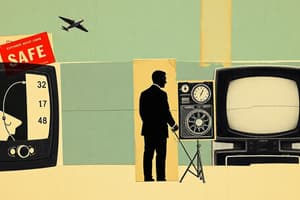Podcast
Questions and Answers
Which component of the communication process emphasizes the importance of the receiver's interpretation and acceptance of the message?
Which component of the communication process emphasizes the importance of the receiver's interpretation and acceptance of the message?
- Context (correct)
- Channel
- Message
- Source
In what way does interference impact the communication process?
In what way does interference impact the communication process?
- It bypasses the channel and conveys the message directly.
- It ensures the message is received exactly as intended.
- It acts as a barrier, preventing effective communication. (correct)
- It clarifies ambiguities in the message for the receiver.
A company wants to inform its employees about a change in policy. Which communication style would be MOST appropriate?
A company wants to inform its employees about a change in policy. Which communication style would be MOST appropriate?
- Formal (correct)
- Grapevine
- Interpersonal
- Informal
What is the value of understanding the components of the communication process??
What is the value of understanding the components of the communication process??
A team spread across different countries needs to collaborate on a project. Considering the limitations of each mode, which communication mode would likely balance efficiency and personal connection?
A team spread across different countries needs to collaborate on a project. Considering the limitations of each mode, which communication mode would likely balance efficiency and personal connection?
In what context would intrapersonal communication be MOST beneficial?
In what context would intrapersonal communication be MOST beneficial?
How does organizational communication contribute to the success of an organization?
How does organizational communication contribute to the success of an organization?
What is the MOST significant impact of technological advancements on communication?
What is the MOST significant impact of technological advancements on communication?
Why is it crucial to blend verbal and non-verbal elements in communication?
Why is it crucial to blend verbal and non-verbal elements in communication?
In a diverse team with members from different cultural backgrounds, how can intercultural communication be improved?
In a diverse team with members from different cultural backgrounds, how can intercultural communication be improved?
Flashcards
Communication
Communication
Sharing and conveying messages or information from one person to another.
Source (Communication)
Source (Communication)
The originator of the message, influencing the target audience.
Message (Communication)
Message (Communication)
Ideas or thoughts conveyed by the sender.
Channel (Communication)
Channel (Communication)
Signup and view all the flashcards
Receiver (Communication)
Receiver (Communication)
Signup and view all the flashcards
Feedback (Communication)
Feedback (Communication)
Signup and view all the flashcards
Environment (Communication)
Environment (Communication)
Signup and view all the flashcards
Context (Communication)
Context (Communication)
Signup and view all the flashcards
Interference (Communication)
Interference (Communication)
Signup and view all the flashcards
Verbal & Non-Verbal Communication
Verbal & Non-Verbal Communication
Signup and view all the flashcards
Study Notes
- Communication has progressed in the last five years, advancing with innovations in technology and social media
- Communication is central to life and culture, and is key for building and strengthening relationships
- Effective communication depends on the ability to communicate effectively
- The purpose of this lesson is to understand the key ideas in communication
Communication Process Components
- Source: The sender who thoughtfully creates the message
- In mass communication, sources can be influencers, gatekeepers, or agenda-setters
- Message: The ideas or thoughts conveyed by the sender to influence their audience
- Messages can be simple or complex
- Channel: The medium through which the message is conveyed
- It is the responsibility of the sender and/or receiver to choose the best channel
- Receiver: The recipient or target of the message
- Receivers are expected to be influenced by the source/sender
- Feedback: The receiver's reaction and/or response to the message
- Environment: The place, feeling, mood, mindset, and condition of both sender and receiver
- Includes the physical setup, space, time, and circumstances
- Context: The sender's "constructed reality" determining how the message is packaged for the receiver
- The goal is to ensure the message is agreeable to the target audience
- Interference: Barriers or difficulties preventing effective communication
- Includes issues, states, or nature of sender and receiver's physical, psychological, cultural, social, economic, and political character, as well as linguistic competencies
Types of Communication
- Communication is classified according to mode, context, purpose, and style
Communication Mode
- Effective communication blends verbal and nonverbal elements
- Verbal communication uses words to interchange information through speech or writing
- Offers clear understanding and immediate feedback
- Nonverbal communication communicates without words through body language, facial expressions, sign language and symbols
- Visual Communication uses visuals to convey information
- Includes signs, symbols, imagery, maps, and graphics
- Interpretation of visuals is crucial
Communication Context
- Intrapersonal Communication: Talking to oneself (inner talk, monologue, or dialogue)
- Aids in practicing what to say
- Interpersonal Communication: Interactive exchange between people
- Extended Communication: Using electronic media for participation despite distance
- Transmits messages quickly
- Organizational Communication: Focuses on communication's role in organizational contexts
- Systems of communication should be created
- Rules or standards for communication protocol should be made clear
- Intercultural Communication: Communication between people with different linguistic, religious, ethnic, social, and professional backgrounds
Purpose and Style
- Formal Communication (Official): Communication in which the sender follows a pre-defined channel
- Employs formal language orally or in writing
- Aims to inform, persuade, or entertain
- Informal Communication (Grapevine): Communication in which the sender doesn't follow pre-defined channels
- Does not employ formal language
- Involves personal and ordinary conversations
Modes of Communication
- Refers to the channel through which one expresses their communicative intent and conveys thoughts/feelings
- Modes include face-to-face, video, audio, or text-based
Face-to-Face
- Preferred mode because it is effective
- Informal or casual conversation between people
- Consider how to speak, what to speak, when to speak, and to whom
- Can note visual cues through facial expressions
Video
- Cameras used to communicate online
- Used with Messenger, Facetime, Skype, and Google Meet
- Convenient for connecting with individuals or groups despite distance
- Regional time differences pose challenges
Audio
- The speaker's voice is heard
- Listening to English native speaker may be challenging
- Can't see physical or body language
Text-based
- Wider reach, quickly disseminates information to a bigger audience
- Does not necessarily take place in real time
- Examples include e-mails, chat, and forums
- Explore various modes to improve message delivery
Studying That Suits You
Use AI to generate personalized quizzes and flashcards to suit your learning preferences.




